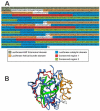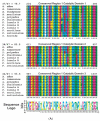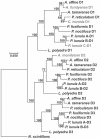New Perspectives Related to the Bioluminescent System in Dinoflagellates: Pyrocystis lunula, a Case Study
- PMID: 32150894
- PMCID: PMC7084563
- DOI: 10.3390/ijms21051784
New Perspectives Related to the Bioluminescent System in Dinoflagellates: Pyrocystis lunula, a Case Study
Abstract
Pyrocystis lunula is considered a model organism due to its bioluminescence capacity linked to circadian rhythms. The mechanisms underlying the bioluminescent phenomenon have been well characterized in dinoflagellates; however, there are still some aspects that remain an enigma. Such is the case of the presence and diversity of the luciferin-binding protein (LBP), as well as the synthesis process of luciferin. Here we carry out a review of the literature in relation to the molecular players responsible for bioluminescence in dinoflagellates, with particular interest in P. lunula. We also carried out a phylogenetic analysis of the conservation of protein sequence, structure and evolutionary pattern of these key players. The basic structure of the luciferase (LCF) is quite conserved among the sequences reported to date for dinoflagellate species, but not in the case of the LBP, which has proven to be more variable in terms of sequence and structure. In the case of luciferin, its synthesis has been shown to be complex process with more than one metabolic pathway involved. The glutathione S-transferase (GST) and the P630 or blue compound, seem to be involved in this process. In the same way, various hypotheses regarding the role of bioluminescence in dinoflagellates are exposed.
Keywords: P630; blue compound; glutathione S-transferase; luciferase; luciferin; luciferin-binding protein.
Conflict of interest statement
The authors declare no conflict of interest.
Figures











Similar articles
-
Bioluminescent Dinoflagellates as a Bioassay for Toxicity Assessment.Int J Mol Sci. 2022 Oct 27;23(21):13012. doi: 10.3390/ijms232113012. Int J Mol Sci. 2022. PMID: 36361798 Free PMC article. Review.
-
Dinoflagellate bioluminescence: a comparative study of invitro components.J Cell Physiol. 1976 Jan;87(1):123-34. doi: 10.1002/jcp.1040870115. J Cell Physiol. 1976. PMID: 1400
-
Dinoflagellate luminescence: purification of a NAD(P)H-dependent reductase and of its substrate.Arch Biochem Biophys. 1986 Dec;251(2):495-503. doi: 10.1016/0003-9861(86)90357-7. Arch Biochem Biophys. 1986. PMID: 3800380
-
Cloning and characterization of an active fragment of luciferase from a luminescent marine alga, Pyrocystis lunula.Photochem Photobiol. 2002 Mar;75(3):311-5. doi: 10.1562/0031-8655(2002)075<0311:cacoaa>2.0.co;2. Photochem Photobiol. 2002. PMID: 11950098
-
Chemistry, clones, and circadian control of the dinoflagellate bioluminescent system. The Marlene DeLuca memorial lecture.J Biolumin Chemilumin. 1989 Jul;4(1):12-9. doi: 10.1002/bio.1170040105. J Biolumin Chemilumin. 1989. PMID: 2678910 Review.
Cited by
-
Bioluminescent Dinoflagellates as a Bioassay for Toxicity Assessment.Int J Mol Sci. 2022 Oct 27;23(21):13012. doi: 10.3390/ijms232113012. Int J Mol Sci. 2022. PMID: 36361798 Free PMC article. Review.
-
Bioluminescence and Photoreception in Unicellular Organisms: Light-Signalling in a Bio-Communication Perspective.Int J Mol Sci. 2021 Oct 20;22(21):11311. doi: 10.3390/ijms222111311. Int J Mol Sci. 2021. PMID: 34768741 Free PMC article. Review.
-
Availability and occurrence of coelenterazine in a Swedish fjord to maintain Amphiura filiformis bioluminescence.Sci Rep. 2024 Dec 30;14(1):31803. doi: 10.1038/s41598-024-82811-y. Sci Rep. 2024. PMID: 39738292 Free PMC article.
References
-
- Widder E. Marine bioluminescence. Biosci. Explain. 2001;1:1–9.
-
- Shimomura O. Bioluminescence: Chemical Principles and Methods. World Scientific Publishing Co. Pte. Ltd.; Singapore: 2012. Revised Edition.
Publication types
MeSH terms
Substances
Grants and funding
LinkOut - more resources
Full Text Sources
Research Materials
Miscellaneous

